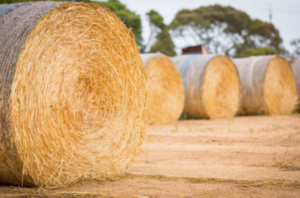Baling twine is used for tying and bundling hay and straw. It comes in various sizes and gauges to suit different needs.
This thick polypropylene twine with UV protection is designed explicitly for baler twine. It comes in several colours.
 It is used for baling hay
It is used for baling hay
Baling twine is a small-diameter sisal or synthetic twine used to fasten hay bales securely. With tensile strengths ranging from 95 psi to 325 psi and using only high-grade raw materials in its manufacturing process, baling twine is one of the premier agricultural staples available today.
Polypropylene (poly) twine with UV protection or sisal twine are two options; either thick polypropylene (poly) with UV protection or natural biodegradable twine for small round and square bales, while more giant bales require poly twine due to its higher tensile strength, which can last for extended periods without degrading.
No matter the baler twine type you select, ensure your baler has enough capacity to bind a whole load of hay. If you find cutting through too much twine before binding triumphant, another baler may be necessary, or you could try another hay-binding method altogether.
When selecting a hay-binding method, it’s essential to consider your forage type, location, storage needs and how you plan to transport the bales. Whether you plan on storing your hay indoors or outdoors, the type of material used will depend on these variables.
Baling twine should have a soft, smooth feel and excellent knot formation to reduce the baler maintenance required. Additionally, it must have high density and sufficient length to achieve an efficient cost per bale; additionally, it must be made from quality virgin raw materials.
As a general guideline, purchasing an appropriate number of feet of twine for each bale you plan on producing is wise. To estimate this, measure the circumference of each bale and multiply it by the number of strands wrapping around each bale.
When disposing of baling twine, place it into a strong plastic bag or bin before throwing it away. Doing this prevents it from blowing out or getting caught in the equipment you discard. Furthermore, pick up any loose twine that falls from above as you move hay from one area to another; doing so helps avoid harm to wildlife or livestock.
It is used for tying bales
Baling twine is a type of twine used to tie and secure bales of materials together. It can be made from either sisal or synthetic materials and comes in various colours and tensile strengths.
Baling twine was first made from sisal, a material composed of individual strands of fibre twisted together. While this type of twine is biodegradable and sustainable, it lacks the tensile strength of synthetic baling twine.
Polypropylene is an artificial plastic much more substantial than sisal and doesn’t break down quickly, making it perfect for tying more giant bales of materials like hay or straw. It comes in various colours and tensile strengths and can be purchased on 1,000 or more feet reels.
Baling twine is not only used for tying bales, but it can be employed in other ways as well. For instance, it could create a sweat scraper and secure items inside vehicles or trucks.
Another widespread use for baling twine is to create a hammock. It can be especially beneficial if you have an expansive yard or garden and need somewhere to unwind.
Baling twine is essential for building projects, as it ties the straw and other materials used in the structure together. Additionally, it helps keep bales the right size; the faster a builder can retie a bale, the smoother the process will run.
Baling twine can be cut into smaller pieces for various uses, such as tying dog collars or headcollars. Ensure the twine you purchase is made from organic material and not chemically treated.
Other options for tying bales include using wire ties. Wire ties are strong but may become tangled and difficult to work with when retying, particularly for square balers that require metal ties.
Double twine arm assemblies are also available to feed twine into the chambers of large round balers. These double arms operate via hydraulic gears and feature adjustability, enabling you to adjust the distance between their dispensing ends.